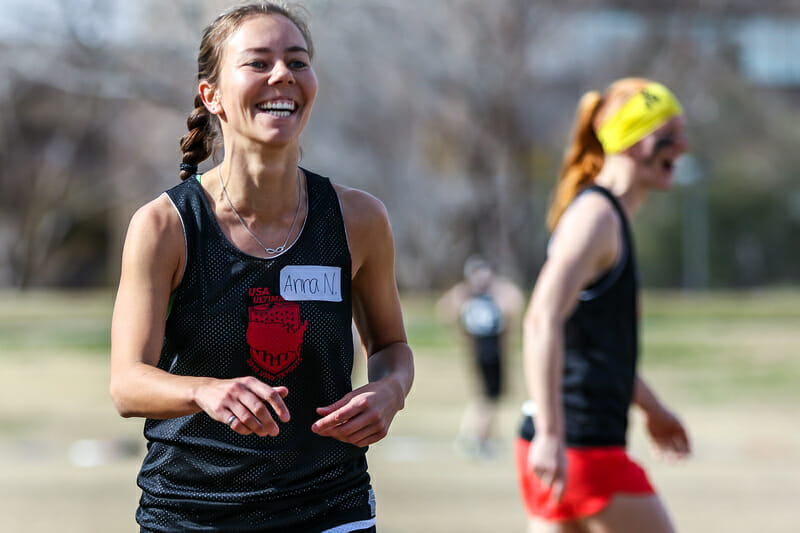3 ways the best players are enhancing their development of new skills.
June 7, 2022 by Melissa Witmer in Opinion with 0 comments

It’s no secret that the greatest players put work into their skills. Team practice simply does not give you the focused reps you need to really work on the needs specific to your own game. Whether it’s shoring up a weakness or developing a superpower, you’re going to need to put in some time outside of practice.
While I know many intermediate players who throw outside of practice, I know fewer who take the time to work on things other than throwing. Throwing, of course, is a foundational skill of ultimate. Putting a lot of hours into throwing makes sense.
But what if you have other things in your game than need work – like defensive positioning, decision making, pulling strategy, or even mental strength training? Do you have a plan for how to work on these things?
To help you be efficient and effective with your time, I’ll share three things I’ve learned as I’ve collaborated with elite players and coaches as we built the programming in our UAP Skills and Techniques membership.
Revisiting the Fundamentals with Greater Focus
One thing all great players have done is to revisit the fundamentals.
When you first start playing, you need to be just good enough at throwing, marking, cutting, catching to be able to play the game. At this stage, more reps will help you get better overall.
But eventually you’ll reach a plateau. In order for skills to improve beyond this intermediate stage, you probably need to revisit a lot of the skills you already know. Sometimes this means taking a step backwards in skill before moving forward. I have yet to meet a high level ultimate player who hasn’t revisited their throwing grip at least once.
While drilling the fundamentals, it might be more difficult to notice big changes than it was when you were a new player. But as you get to higher levels, it’s those small differences that add up and can make the difference between a block and a completion.
Working on the smaller details has a much bigger payoff at this stage.
In this drill by Robyn Fennig, players focus on gaining control of their upper body movement while avoid overreacting by leaning over and thus overcommitting their weight to one foot.
This is a great example of a player really rethinking the minute details of a skill to figure out how to make their movement more efficient.
Incorporating Elements of Visualization
Almost every module we have in the UAP Skills and Techniques membership incorporates some element of visualization.
This is one of my favorite drills from Mario O’Brien. The most important part of the drill is what you cannot see – the stuff that is going on in his head.
Mario’s drill feels at once familiar and foreign. I do this type of visualization practice and also recognize that it looks a bit ridiculous watching someone else do it.
But it reminds me of all of the unique exercises we’ve had over the years in the UAP S&C program. Growth happens when we are ready and willing to look silly in order to get results!
The effectiveness of visualization is well established, yet it remains underutilized. And in our Coaching and Game IQ membership I cover how I train it, and why I think more athletes don’t use it despite it being one of the most robustly studied methods of performance improvement.
Another example is Micheal Caldwell incorporating visualization into his conditioning routines.
Having Fun Helps
The most surprising thing I learned from these drills from the best is that it’s okay, in fact beneficial, to have some fun.
Many drills, like Brett Matzuka’s and John McNaughton’s creative throwing drills and Colin McIntyre’s Backhand Hucks and Pulls drills, use games as part of their practice.
Games are a helpful learning tool because scoring gives us more clear indicators of success and failure feedback. Games help us get focused on the results we are trying to produce rather than focusing too internally on what we are doing – this is a fundamental principle of motor skills learning.
Having fun helps you to loosen up and allows the mind to be curious. A curious mind is a learning mind.
I should not be surprised that fun is an important element. After all, play is an important part of the learning process for children. The connection between fun and learning doesn’t need to disappear for adults.
Next Steps
Take these principles and use them as you’re designing your own ultimate improvement activities.
If you’d like a program of drills and progressions already designed for you, sign up for our UAP Skills & Techniques membership. Each module is designed to be done by yourself or with a partner (though I use these drills in coaching clinics with teams around the world too).
On the website, we have more than a year’s worth of ultimate skills programming. Choose a pathway for being a better handler, cutter, or defensive specialist. Or choose your own adventure by picking and choosing the modules that most interest you.